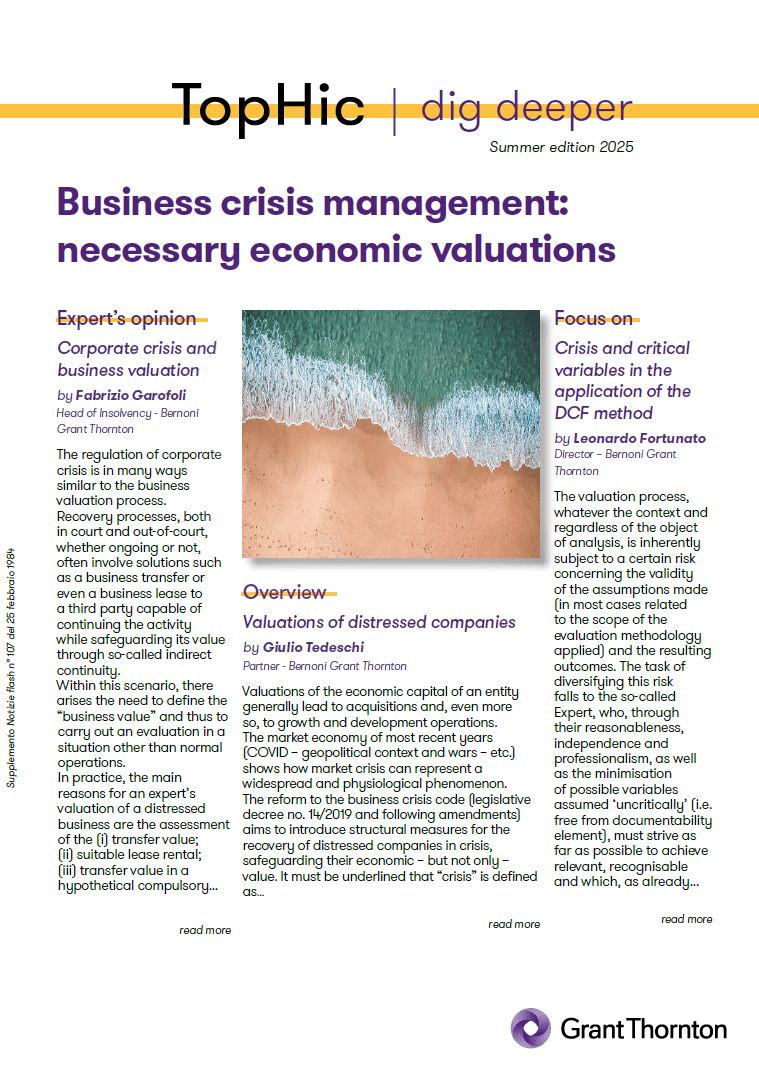
The valuation process, whatever the context and regardless of the object of analysis, is inherently subject to a certain risk concerning the validity of the assumptions made (in most cases related to the scope of the evaluation methodology applied) and the resulting outcomes. The task of diversifying this risk falls to the so-called Expert, who, through their reasonableness, independence and professionalism, as well as the minimisation of possible variables assumed 'uncritically' (i.e. free from documentability element), must strive as far as possible to achieve relevant, recognisable and consistent results, taking into account the information assets at their disposal and the related micro and macroeconomic context (and likely forecasts).
In a context of ‘crisis’, which, as already mentioned, refers to ‘the economic and financial difficulty that makes the debtor's insolvency likely, and which for companies manifests itself as the inadequacy of prospective cash flows to meet planned obligations on a regular basis’, the expert plays a key role since he/she is assigned the task of quantifying, from an economic and financial perspective, company prospective or liquidity scenarios (in some cases also related to individual assets), on the results of which depends the possible satisfaction of the related stakeholders (shareholders, creditors, lenders) as well as the choice of the best strategic option from a procedural perspective (e.g., transfer, liquidation).
After recalling the essential role of the expert, though in very general terms, it is therefore worth highlighting the main variables that can undermine the correct implementation of methodologies and the identification of underlying correlations in the context of a company valuation in ‘crisis’.
Valuation methods
As also pointed out by the OIV (Italian valuation body) in its latest discussion paper (No. 1/25) there should be no specific methods for the valuation of distressed companies, as the “traditional” methods - which can be adapted to possible different variations - are, in principle, sufficient for determining the value of business assets, even in a context of “crisis”.
Although it is true that traditional methods (i.e., income approach, market approach, cost approach) are readily applicable even in contexts of “crisis”, for reasons of brevity, the following section will refer to the main points to be considered when applying methods based on cash flows (the so-called Discounted Cash Flow Method) in a context of possible business continuity once the state of crisis has been ascertained, as these are considered to be more applicable and used in the contexts under analysis.
Key points to consider when using the DCF method
As summarised by the OIV (document mentioned above), when applying cash flow-related methods, the main points for the expert to consider are “essentially” the following:
- The risks inherent in the business plan supporting the corporate restructuring project: first of all, it is pointed out that the development of a business plan is a fundamental part of a corporate restructuring process aimed at medium- to long-term continuity (‘The plan identifies the steps through which the company intends to carry out restructuring’). From a primarily evaluative perspective, the development of a business plan - in such a context - is particularly subject to a number of inherent risks, which can be summarised as follows: A) the typical risk of a business plan, which is generally inherent to i) systematic risk (and, theoretically, difficult to diversify), ii) scenario risk (i.e., determining cash flows based on specific assumptions), and iii) execution risk, i.e., when the plan itself provides for specific initiatives/strategies to be undertaken. These risks, as also pointed out by the OIV, must be taken into consideration by the expert both in relation to a preliminary analysis aimed at assessing the correct (basic) construction of the plan itself and, above all, in weighing up an appropriate discount rate that can properly summarise these risks, always taking into account the specificities under analysis. Another intrinsic risk is the possibility of failure of the plan, which in turn must be weighed in the variables underlying the discounting of the reference cash flows (e.g., by strengthening the discount rate through specific rates or by independently calculating an estimate of the probability of default of the plan itself).
- Identifying a suitable discount rate of flows originating from the plan: beyond the possible “crisis” scenarios, the identification of a suitable discount rate always plays a key role for the correct calculation of the actual value of expected flows. In short, two of the most important macro-components to be considered when calculating a discount rate are: i) first of all, the variables which summarise the systematic risk and the “generic market risk” which in most cases is assessed through a CAPM approach; ii) secondly, the identification of all those “additional” rates aimed at customising the discount rate to be applied to the case at stake (consider the scenario and/or execution and/or plan failure risk). Very often, when considering the abovementioned two macro-components - also given the prudential approach the expert must adopt in such contexts - there is the possibility of double counting the valuation of the same risk (e.g. a scenario risk also considered as an execution risk).
- Estimating the Terminal Value: the terminal value is an additional value to be determined carefully and attentively (usually a significant part of valuation results depend on this variable). In a “crisis” context, it will most probably not be sufficient to determine it on an “historical” basis, but rather - as also suggested by the OIV - analytically. Many of the variables taken as reference to determine multi-year flows can actually undergo considerable changes in an “indeterminate” perspective, such as the return to a functional and thus income stability. By way of example, it is worth considering the trend of revenues or, more specifically, the effect of long-term CAPEX (against investments already made during the plan, which do not need repeat significant investments) or also the tax variables (e.g. the use of previous tax losses to abate future income).
In addition to what briefly explained above, it is clear that the expert, in an Income approach logic (i.e. DCF), must also keep into account other factors, with the final aim to determine a value as specific and as objective as possible (consider, for example, the financial variable of the plan both for its effects on flows and as for the discount rate, or contractual arrangements in a “crisis” context underlying the generation of revenues, or the "regenerated" movement of net working capital). It is advisable, where applicable, that the outcome of the analyses be validated with the application of an alternative valuation method (e.g. the multiples method, with all necessary precautions required by the application of such method in a crisis context) aimed at confirming the results obtained by the main method chosen.
Closing remarks
The methodological application and the choice of the underlying and related significant variables are key processes that the expert - also and above all in a “crisis” situation - is required to deal with when devising a valuation project. In a context where a company is not carrying out normal business operations, attention to peculiar and fundamental aspects - both endogenous and exogenous in a "crisis" - is key to achieving consistent and reasonable valuation results. When planning the method to adopt (e.g. as for DCF), the expert must valorise different risks and scenarios, which require specific targeted interventions aimed at weighing up “additional” and hardly predictable variables.
